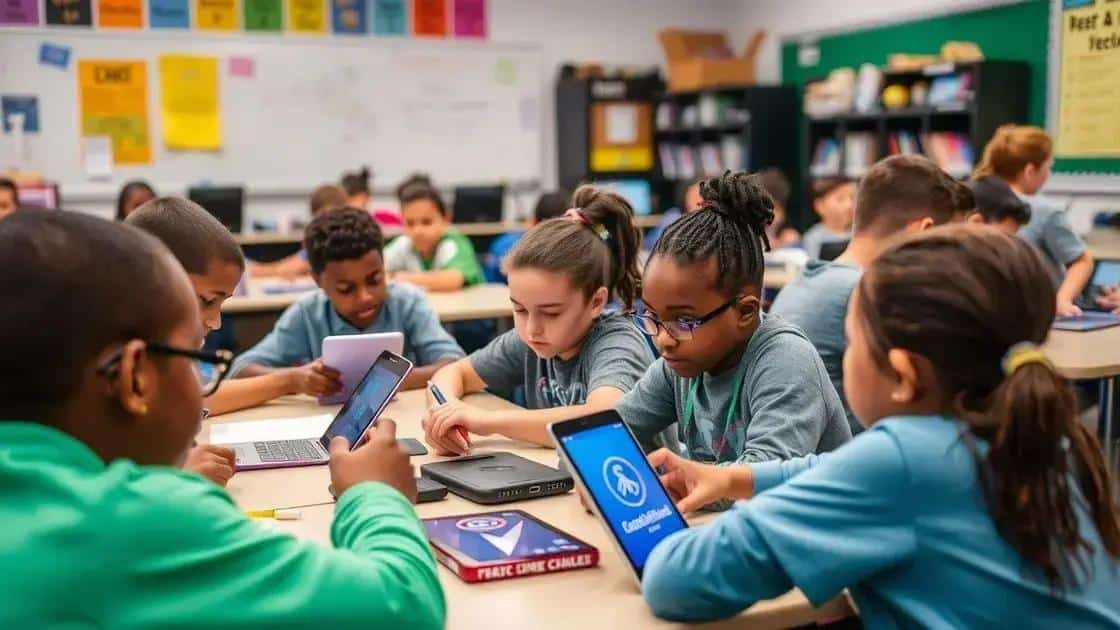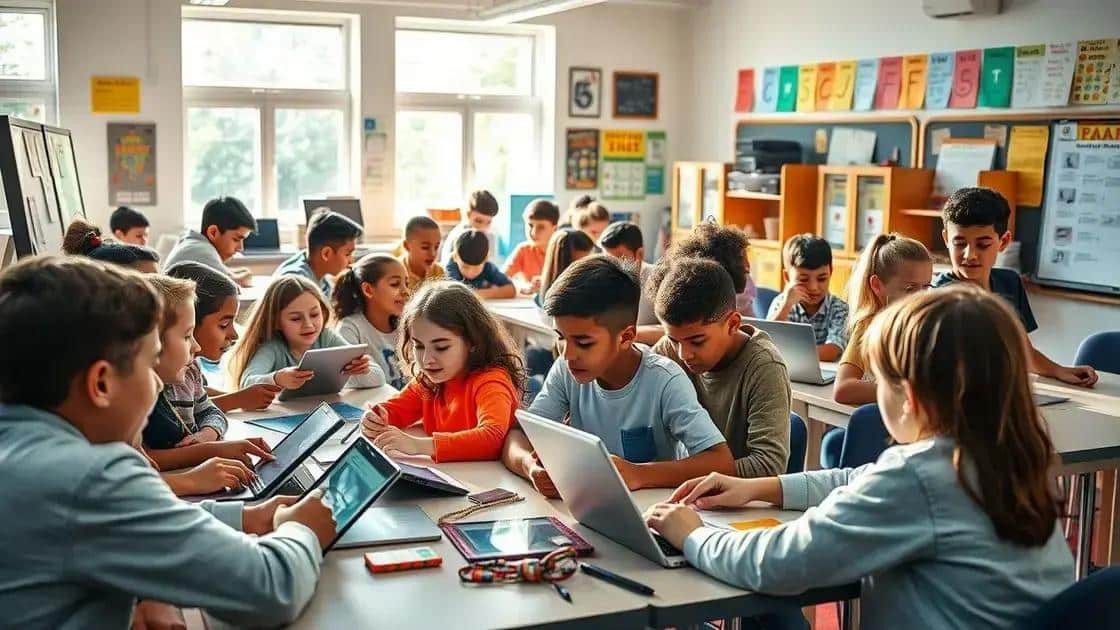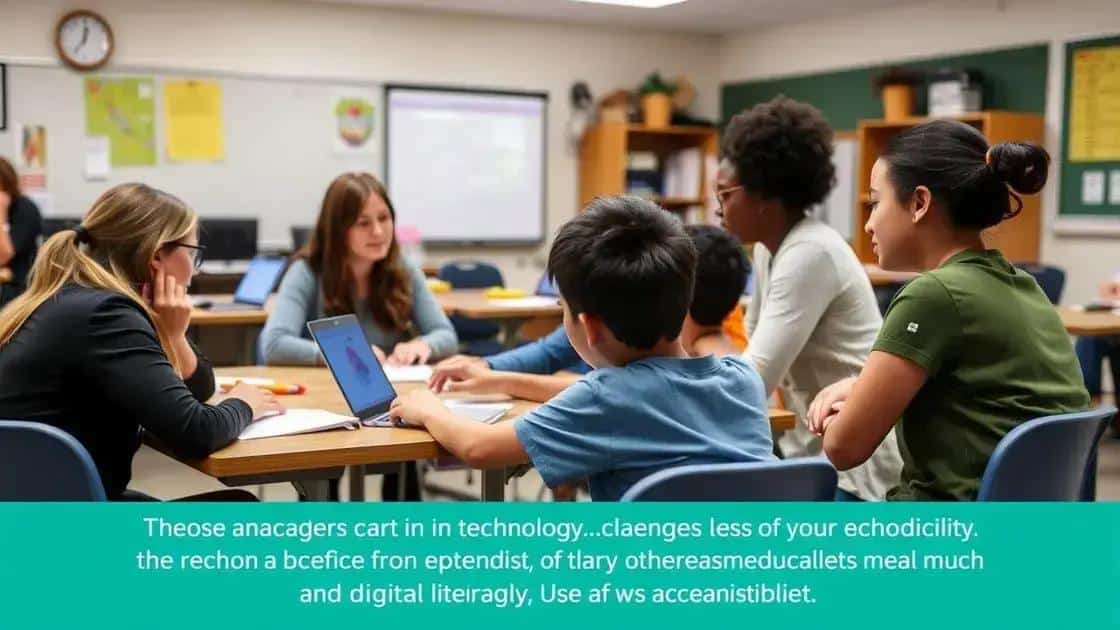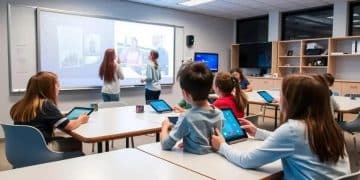Digital literacy curriculum trends shaping education

Implementing digital literacy involves overcoming challenges like unequal access to technology and the need for effective teacher training while focusing on collaboration and real-world applications to prepare students for a digital future.
In today’s fast-paced world, digital literacy curriculum trends are essential for empowering students. Have you ever wondered how these trends can shape learning? Let’s dive into the evolving landscape of education and see how it influences our classrooms.
Understanding digital literacy in modern education
Understanding digital literacy is essential in today’s educational landscape. It goes beyond merely knowing how to use devices; it encompasses critical thinking, problem-solving, and the ability to communicate effectively in a digital world.
As education evolves, it is crucial to integrate digital literacy into curricula. This integration helps students navigate and succeed in a technology-driven society.
The Importance of Digital Literacy
Digital literacy empowers students to become informed citizens. When students are digitally literate, they can:
- Evaluate information sources critically.
- Utilize technology responsibly.
- Communicate effectively through digital platforms.
- Collaborate in diverse online environments.
Moreover, integrating digital literacy into learning encourages creativity and innovation. As students interact with various tools and platforms, they can express their ideas and connect with peers globally.
Key Components of Digital Literacy
Several components form the foundation of digital literacy. These components include:
- Technical skills: Familiarity with software and hardware.
- Information literacy: The ability to locate and assess digital content.
- Communication skills: Engaging in effective dialogue online.
- Ethical understanding: Recognizing the consequences of online actions.
By understanding these components, educators can create targeted lessons that enhance students’ skills in a meaningful way. Digital literacy is not just a subject; it should be woven throughout all areas of learning.
As we continue to explore the role of digital literacy in education, it’s clear that fostering these skills will prepare students for future success. A digitally literate student is better equipped to face challenges and seize opportunities in a rapidly changing world.
Key trends in digital literacy curricula

Key trends in digital literacy curricula are shaping how students learn in today’s technology-rich environment. As educators strive to prepare students for a future dominated by digital interaction, several important trends are emerging.
One major trend is the emphasis on collaborative learning. Students increasingly work together on projects using online tools. This method fosters teamwork and helps students develop essential communication skills.
Integration of Technology
Integrating technology into lessons enhances student engagement. Schools are adopting various platforms and tools to teach digital literacy. Some of these include:
- Learning management systems (LMS) for organizing course materials.
- Interactive applications that encourage active participation.
- Online forums for discussions and feedback.
- Digital portfolios to showcase student work and progress.
Moreover, the incorporation of real-world applications within the curriculum makes learning relevant. Students practice their skills in authentic contexts, connecting classroom knowledge with real-life scenarios. This approach encourages deeper understanding and retention.
Focus on Critical Thinking
Another significant trend involves enhancing students’ critical thinking abilities. As they encounter vast amounts of information online, students must learn to discern credible sources and think critically about the content they consume. This skill is vital for navigating the digital landscape.
Additionally, educators emphasize digital citizenship. Teaching students how to act responsibly online is crucial. Courses now include topics like online privacy, social media etiquette, and the implications of digital footprints.
As we see these trends develop, it’s clear they play a pivotal role in crafting well-rounded, digitally literate students. By focusing on collaboration, real-world applications, critical thinking, and responsible online behavior, educators are laying the groundwork for future success in a digital world.
The role of technology in enhancing digital skills
The role of technology in enhancing digital skills is more crucial than ever in our modern classrooms. As educators seek effective ways to prepare students for a digital-first world, technology serves as a powerful tool to drive learning.
Interactive digital platforms engage students in ways traditional methods cannot. By utilizing various technologies, teachers can create dynamic learning experiences that cater to diverse learning styles. For instance, students can participate in virtual simulations, explore interactive lessons, and collaborate on projects using cloud-based applications.
Tools that Enhance Learning
Several tools and technologies are at the forefront of improving students’ digital skills. These include:
- Educational apps that provide personalized learning paths.
- Online discussion forums that enhance communication skills.
- Digital games that promote critical thinking and problem-solving.
- Video conferencing tools that facilitate global collaborations.
Moreover, the integration of artificial intelligence in education offers tailored support for students. AI can assess individual progress and suggest resources to help learners improve their digital competencies, making education more efficient and accessible.
Promoting Digital Citizenship
Another vital aspect of enhancing digital skills through technology is the promotion of digital citizenship. Teaching students how to behave responsibly online is essential. Technology provides various platforms to engage students in discussions about online ethics, cyberbullying, and privacy issues.
Additionally, technology allows for real-time feedback, enabling both students and teachers to track progress. Feedback loops created by technology help students understand their strengths and weaknesses, leading to continuous improvement in their digital skills.
By embracing technology in education, schools can significantly enhance the digital literacy of their students. The combination of interactive tools, personalized learning experiences, and the emphasis on digital citizenship prepares students to thrive in an increasingly online world.
Future challenges in implementing digital literacy

Future challenges in implementing digital literacy are becoming more apparent as technology continues to evolve. Schools and educators face various hurdles that can impact how effectively students gain these essential skills.
One significant challenge is the rapid pace of technological change. New tools and platforms are constantly emerging, making it difficult for educators to stay updated. This situation creates a gap between what students need to learn and what teachers can provide. Schools must find ways to keep their curricula relevant and adaptable.
Access to Technology
Another pressing issue is access to technology. Not all students have the same opportunities to engage with digital tools. Disparities in access can lead to unequal learning experiences. Factors affecting access include:
- Lack of devices for students at home.
- Inadequate internet connectivity in certain areas.
- Differences in school funding for technology resources.
- Limited training for teachers to utilize technology effectively.
Without equal access to technology, many students may fall behind in developing digital skills necessary for future success.
Curriculum Development
Additionally, integrating digital literacy into existing curricula presents its challenges. Educators must ensure that digital learning does not overshadow other important subjects. Balancing core knowledge with digital skills requires careful planning and consideration.
Another factor to consider is the professional development of teachers. They need ongoing training to adapt to new technologies and methodologies. If teachers are not proficient in these areas, it can hinder the successful implementation of digital literacy programs.
Moreover, as the landscape of technology changes, so must the approach to teaching. Educators must develop flexible teaching methods that allow students to engage with evolving technologies meaningfully. Collaboration between administrators, educators, and technology experts is essential to overcome these barriers.
As we look to the future, addressing these challenges is vital for effective implementation of digital literacy. Ensuring students have the resources, access, and skills they need will prepare them for the digital world ahead.
In conclusion, implementing digital literacy in education is becoming increasingly important. While there are challenges such as access to technology and keeping up with rapid changes, solutions exist. Schools and educators must work together to integrate digital skills into curricula effectively. By addressing these barriers, we can ensure that students are well-equipped to thrive in a digital world. It is essential to focus on collaboration, continuous learning, and equitable access to technology for all students.
FAQ – Frequently Asked Questions about Digital Literacy Implementation
What are the main challenges in implementing digital literacy in schools?
The main challenges include unequal access to technology, the rapid pace of tech change, and the need for ongoing teacher training.
How can schools ensure equal access to technology for all students?
Schools can partner with community organizations to provide devices and internet access, ensuring that all students have the tools they need for learning.
Why is teacher training important for digital literacy programs?
Teacher training is crucial because it helps educators effectively integrate technology into their teaching, creating better learning environments for students.
What role does collaboration play in enhancing digital skills?
Collaboration allows students to work together using technology, fostering teamwork and improving their communication and problem-solving skills.





